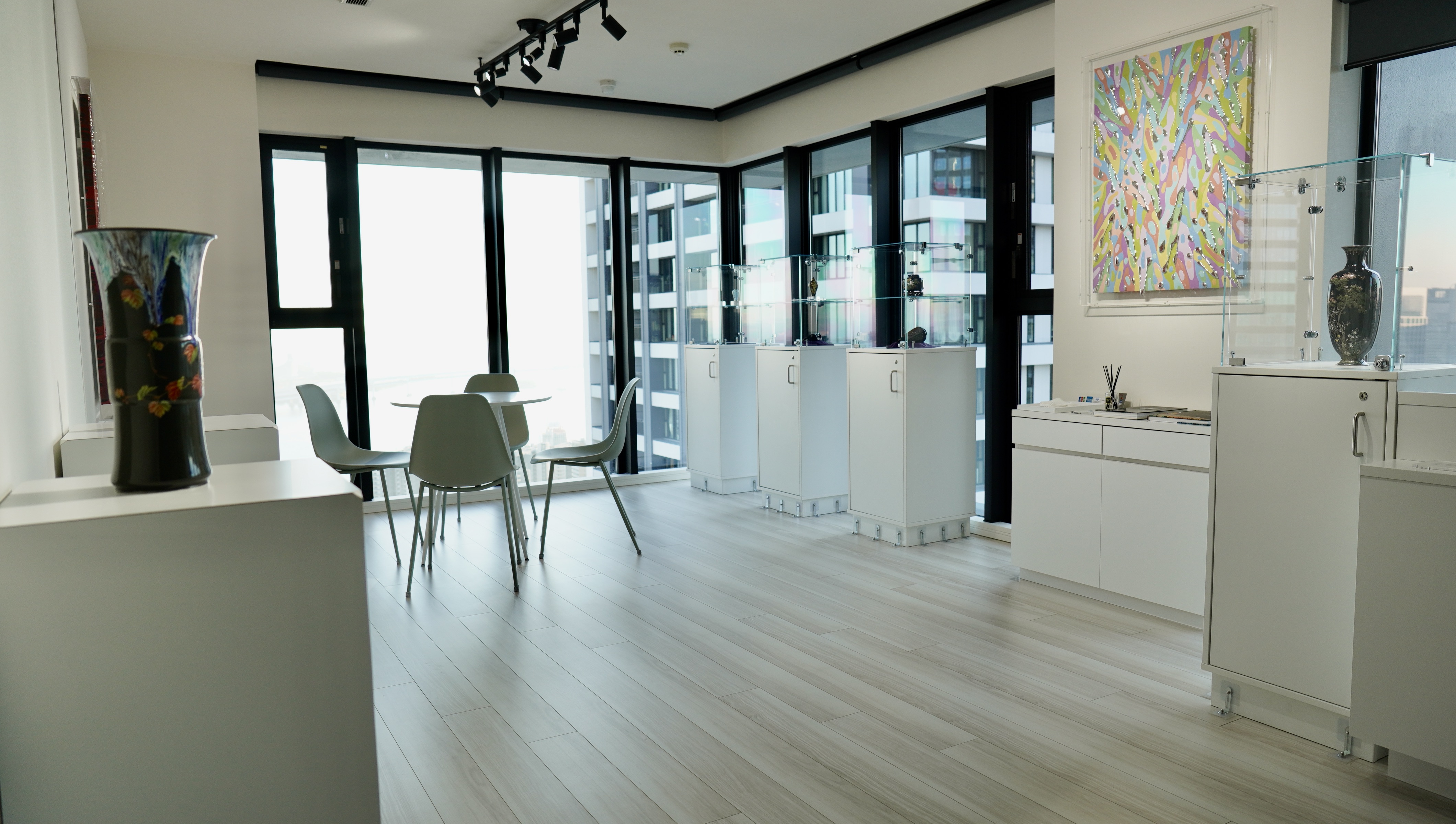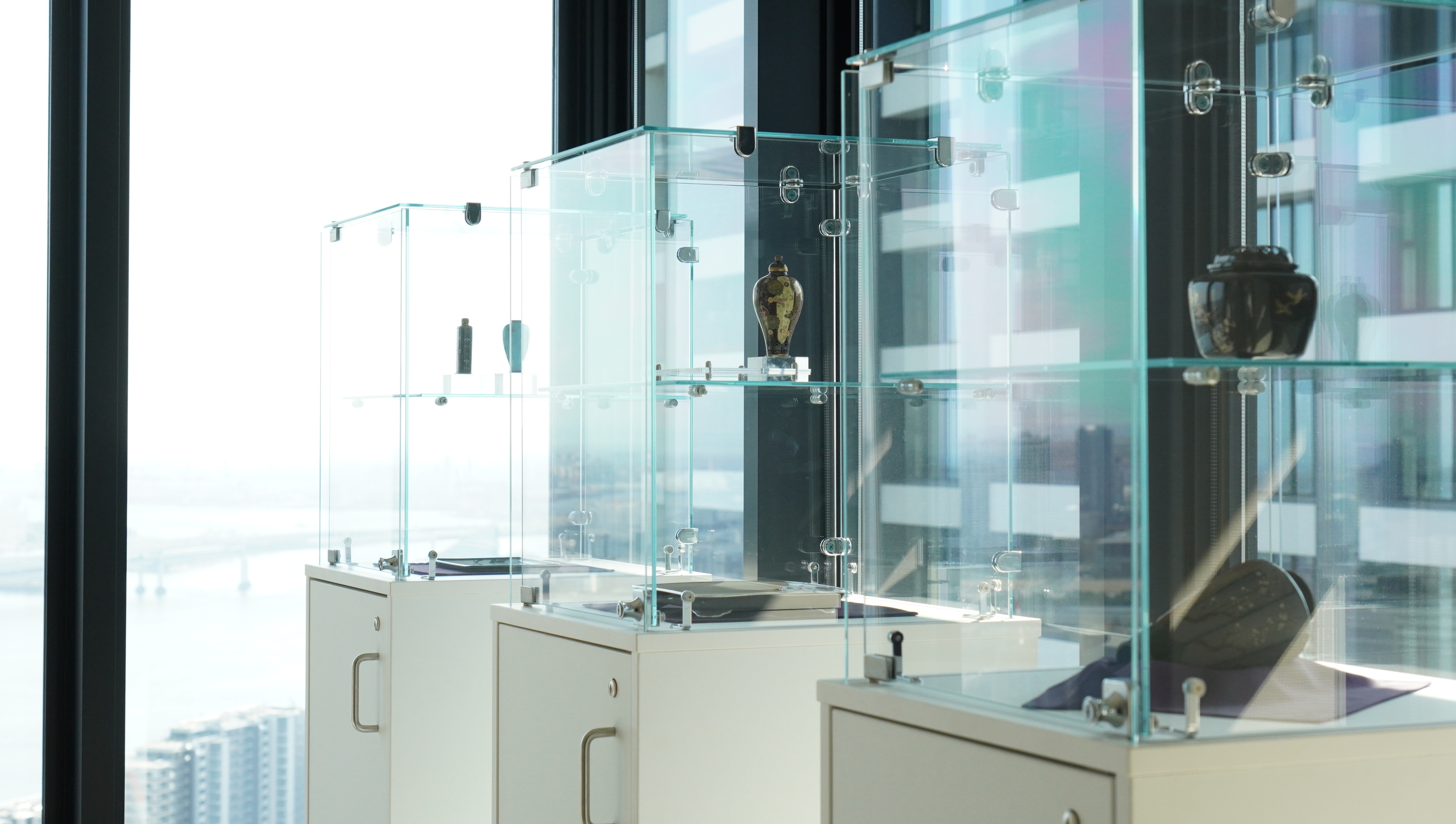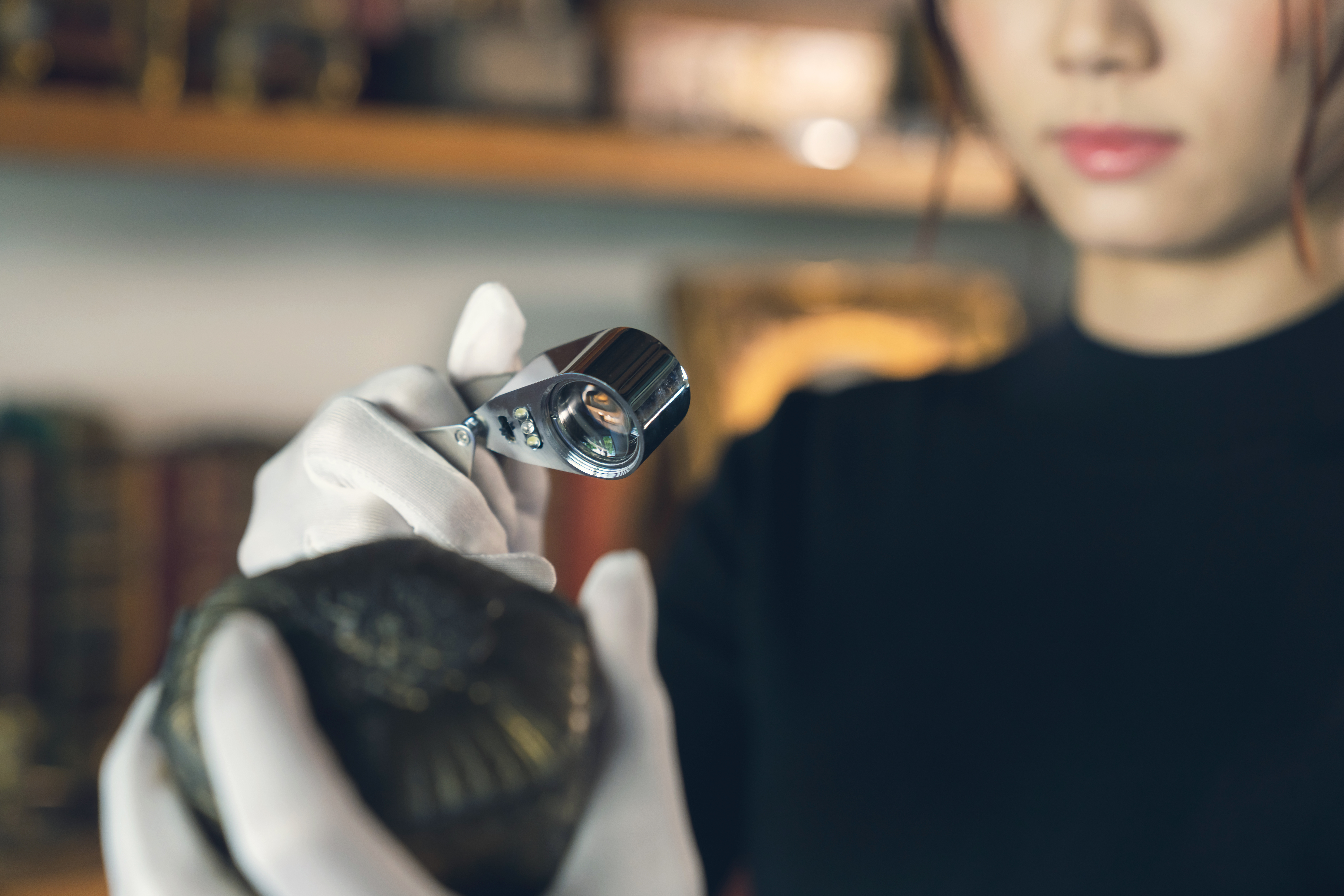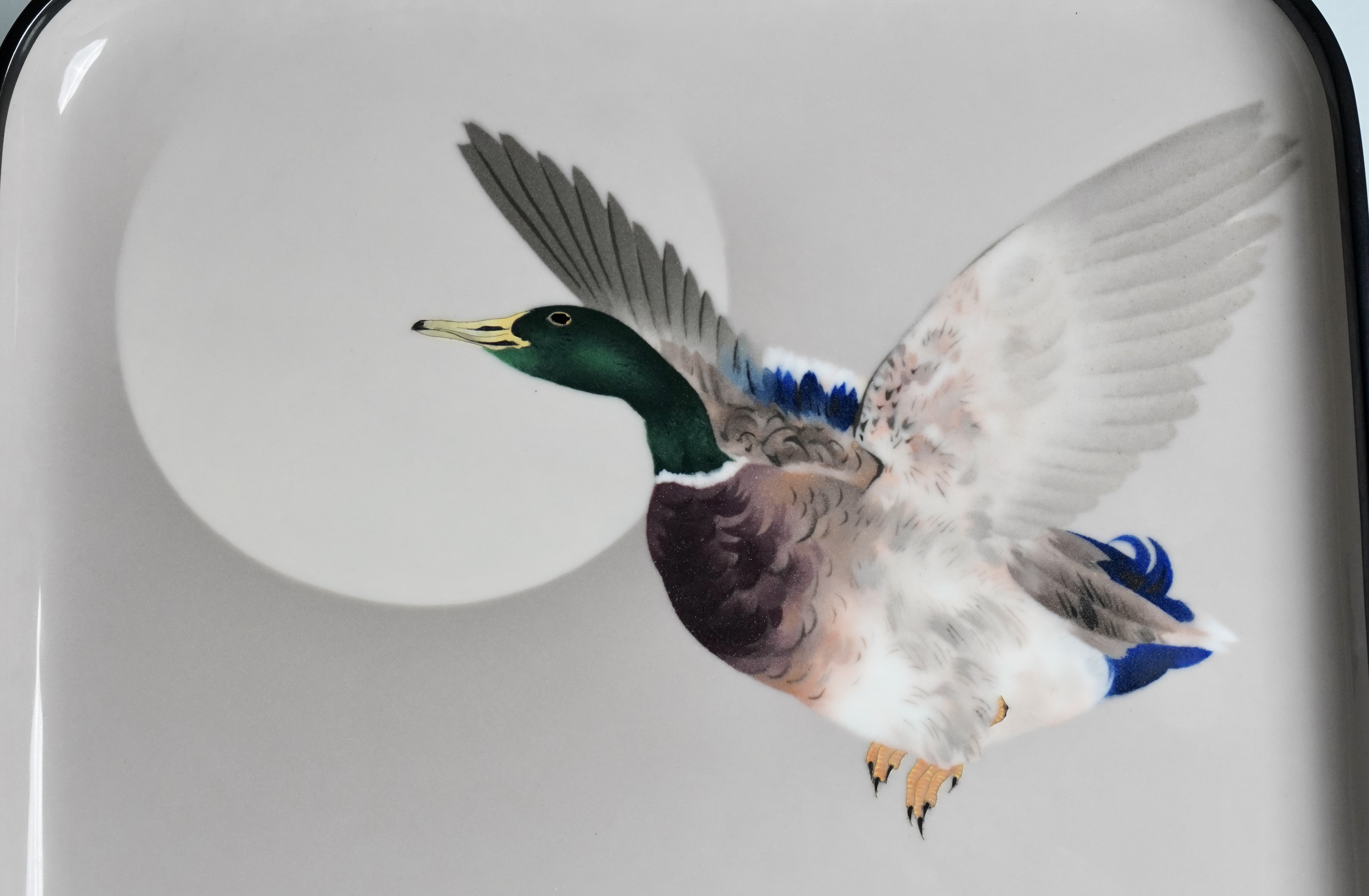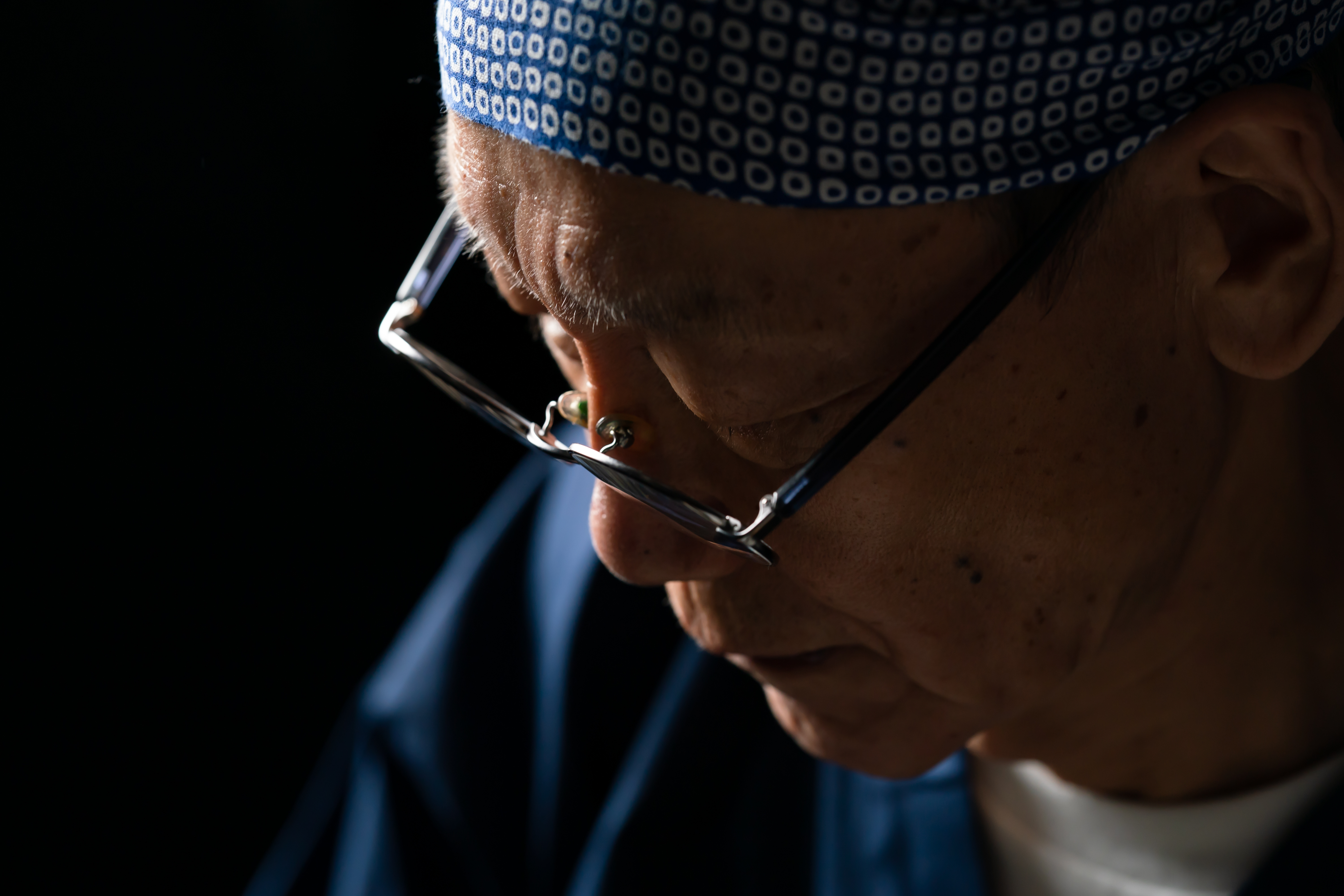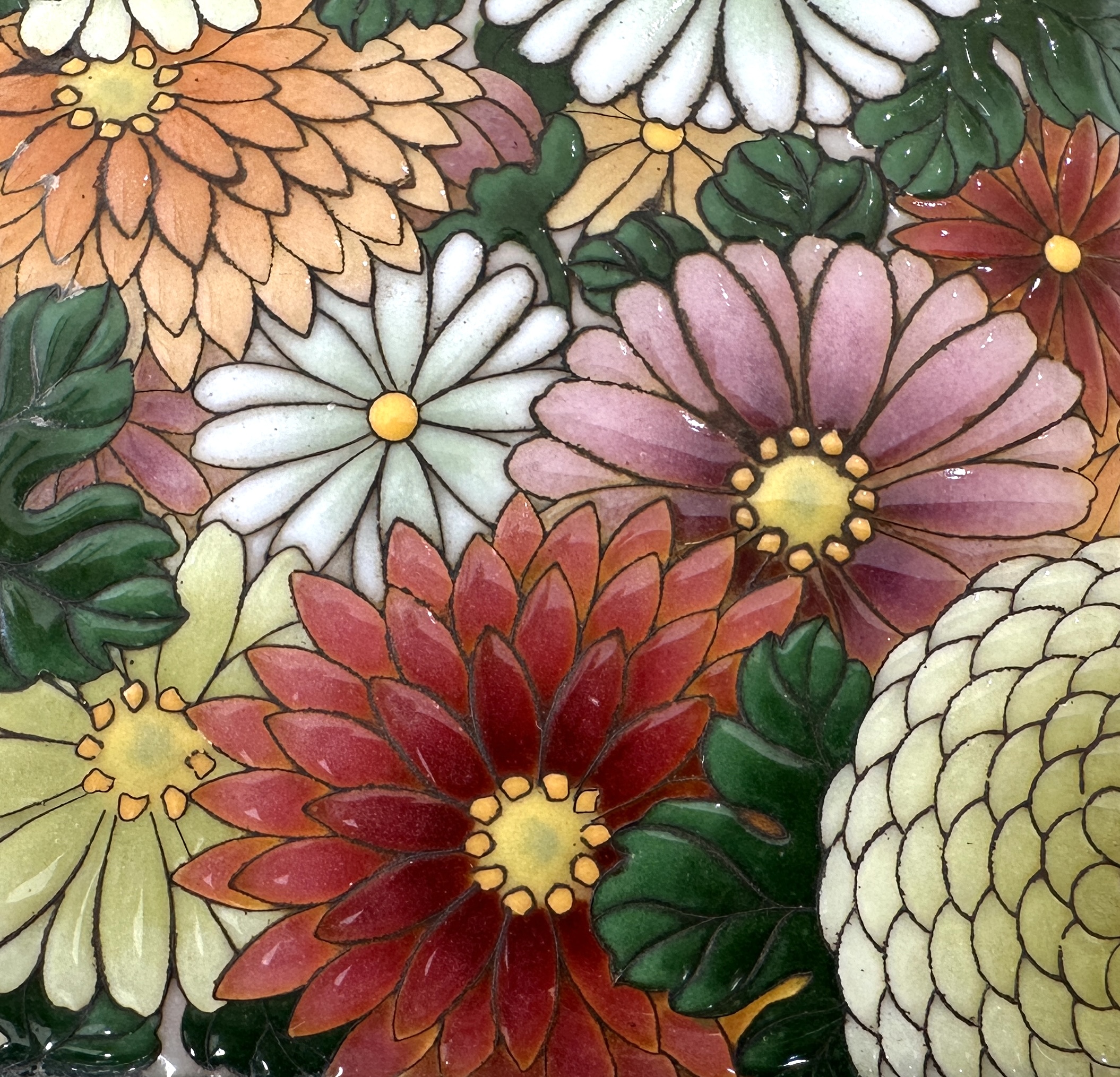Who is Namikawa Yasuyuki ? Legendary Meiji Cloisonne Ware Artist – History,Characteristics,and Locations Where His Works are Sold
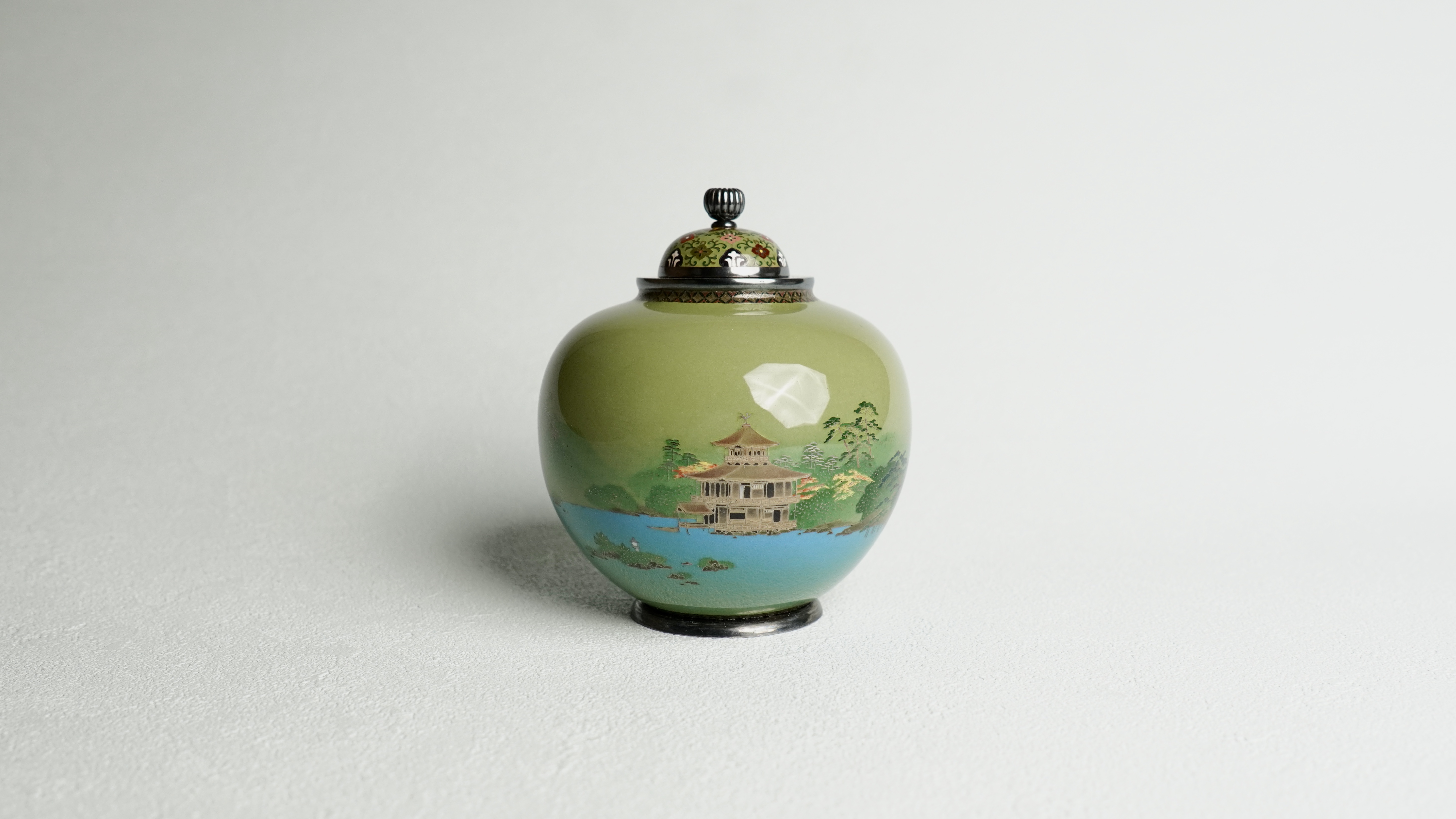
How much do you know when you hear the name Yasuyuki Namikawa?
You may have heard of the name, but few people may know more about the full scope of Yasuyuki Namikawa’s work or the footprints he has left in the world.
“What kind of artist is Yasuyuki Namikawa?”
“Please tell me the history of Yasuyuki Namikawa!”
“What are some of the famous works of Yasuyuki Namikawa and what are the characteristics of his works?”
“Where can I find his works for sale?”
Here is a complete description of Yasuyuki Namikawa, including his personality and the many works he has created.
In this article, we will explain the life, works, and history of Yasuyuki Namikawa, and provide in-depth information on the price quotations of his works, books and publications related to him, and information on his exhibitions.
By reading the article, you will understand the artistic talent and influence of Yasuyuki Namikawa and learn how to approach his work.
It will also help you make informed decisions when purchasing art, and provide you with a new perspective on Japanese art and culture that you can use to gain a deeper understanding of Japanese art and culture.
So, let’s explore the world of Yasuyuki Namikawa together.
- About Namikawa Yasuyuki
- History and Chronology of Yasuyuki Namikawa
- Yasuyuki Namikawa’s Career as a Cloisonne Artist
- Yasuyuki Namikawa – The four periods and their respective styles
- Characteristics of Yasuyuki Namikawa’s cloisonne enamel ware works
- Prices and Quotations of Yasuyuki Namikawa’s Works
- Namikawa Cloisonne Museum of Kyoto
- What is his relationship with Sosuke Namikawa, who was said to be his rival?
- Museums where you can see the works of Yasuyuki Namikawa
- FAQ
- What are some of Yasuyuki Namikawa’s representative works?
- Works by Yasuyuki Namikawa available for sale and viewing at [Ginza Shinseido]
About Namikawa Yasuyuki
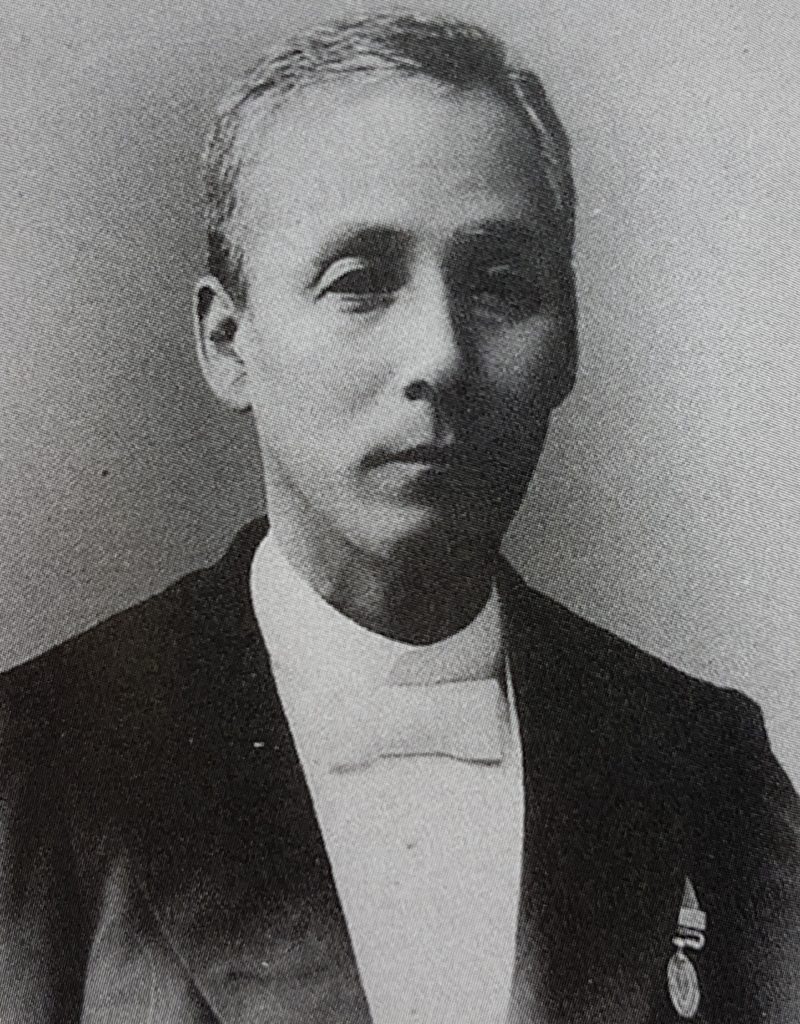
Yasuyuki Namikawa became a cloisonne enamel artisan in the Meiji era.
Yasuyuki Namikawa, who revolutionized the world of traditional Japanese crafts during the Meiji era, is one of the most talked-about cloisonne ware artisans to this day.
With his sophisticated techniques and vivid colors, Yasuyuki Namikawa’s works have attracted art lovers from all over the world.
They are highly regarded among Japanese crafts of the Meiji era and still fetch high prices today.
He invented “wired cloisonne enamel ware,” a method of separating color boundaries using a band of silver wire, which is now the basis of cloisonne enamel ware making.
He also invented black transparent glaze and created a Japanese-style painting with fine color expression by using gold and silver wire, and is a representative artist of the Meiji cloisonne enamel ware world together with Sosuke Namikawa of wireless cloisonne enamel ware.
History and Chronology of Yasuyuki Namikawa
| Era | 主な出来事 |
| 1845 | 川越藩家臣・高岡九郎左衛門の三男として京都に生まれる。 |
| 1855 | 11歳のとき、親戚の並河家の養子となって家督を継ぎ、青蓮院宮(のちの久邇宮)近侍となる。 |
| 1873 | 宮家に仕える傍ら七宝業に取り組むようになり、国内外の博覧会に作品を出品。数々の受賞を果たす。 |
| 1874 | 桃井英升を招き、尾張七宝の技術指導を受けます。 |
| 1875 | 第4回京都博覧会にて花瓶の七宝焼きを出品し、有功銅賞を受賞します。 |
| 1876 | フィラデルフィア万国博覧会 銅賞を受賞。 |
| 1877 | 第1回内国勧業博覧会 鳳紋賞牌受賞。 |
| 1878 | 東京で七宝釉薬の改良を指導していたドイツのワグネルが京都の舎密局に着任。 並河はパリの万国博覧会に銀製七宝茶入を出品し、銀賞を受賞します。 この年に青蓮宮侍臣を辞め、七宝業に専念します。 並河の有線七宝は殖産興業の波に乗り、久邇宮家従を辞して、七宝製造業に専念する。 一時期事業が低迷するも、釉薬を改良し金属線を金銀に換え、透明感のある艶やかな黒地に、 絵筆のような繊細な植線づかいで華麗な花鳥風月の世界を描き出し、七宝を極めていきます。 |
| 1881 | 第2回内国勧業博覧会 入賞。 |
| 1883 | アムステルダム植民地産物及び一般輸出品万国博覧会 銀賞受賞。 |
| 1885 | ロンドン万国発明品博覧会に出品して銅賞受賞。 ニュールンベルク金工万国博覧会に出品し銀賞・紀念賞受賞。 ニューオリンズ万国博覧会に出品して一等金賞を受賞。 |
| 1888 | バルセロナ万国博覧会 銀賞受賞。 |
| 1889 | 日本美術協会会員となり、パリ万国博覧会に出品し、金賞を受賞します。 |
| 1890 | 京都美術協会を発足し、評議員となります。第3回内国勧業博覧会に鳳凰唐草紋七宝花瓶を出品し、 妙技一等賞を受賞します。 |
| 1892 | 京都市美術工芸品展覧会 金牌の功労賞受賞。 |
| 1893 | 緑綬褒章を受章。 シカゴコロンブス万国博覧会 銅牌受賞。 |
| 1894 | 並河邸(個人邸宅兼工房)竣工。 |
| 1895 | 第4回内国勧業博覧会 妙技一等賞受賞。 |
| 1896 | 帝室技芸員となり、工芸家としての地位を確固たるものとした。大正期に入り、 七宝業の衰退とともに工房を閉鎖。 |
| 1900 | パリ万国博覧会 金賞受賞。 |
| 1903 | 第5回内国勧業博覧会に金線七宝竹図花瓶を出品し、二等賞を受賞。 |
| 1904 | 第5回内国勧業博覧会 二等賞受賞。 |
| 1910 | ロンドンの日英博覧会 金牌受賞。 |
| 1923 | 七宝工房を閉鎖します。 |
| 1927 | 病気のため5月24日に 83年間の生涯を終える |
Yasuyuki Namikawa devoted 83 years of his life to making cloisonne enamel ware.
Yasuyuki Namikawa’s Career as a Cloisonne Artist
After serving His Imperial Highness Prince Kuninomiya Asahiko, Yasuyuki Namikawa began working in the cloisonne enamel art business after the Meiji Restoration. Without knowledge or materials, he learned the techniques through trial and error. In 1873, he completed his first work, “Cloisonne Phoenix Design Food Basket”.

(The first work of Yasuyuki Namikawa, Cloisonne)
At that time, cloisonne enamel ware was mostly known as “mud cloisonne,” a glaze with no luster.
Owari cloisonne enamel ware was ahead of cloisonne enamel ware in terms of glaze improvement, and Yasuyuki Namikawa was strongly shocked when he saw Owari cloisonne enamel ware made with a transparent glaze (a glaze with a transparent, glassy sheen) at the National Industrial Exhibition of Japan.
Immediately, Yasuyuki Namikawa, together with underglazier Tessen Nakahara, Wagner, and others, proceeded with their research.
The result of their efforts was that Namikawa eventually produced more types of glaze colors than any other cloisonne enamel workshop. In particular, the black transparent glaze was highly regarded and is called “Namikawa Black” in modern times.
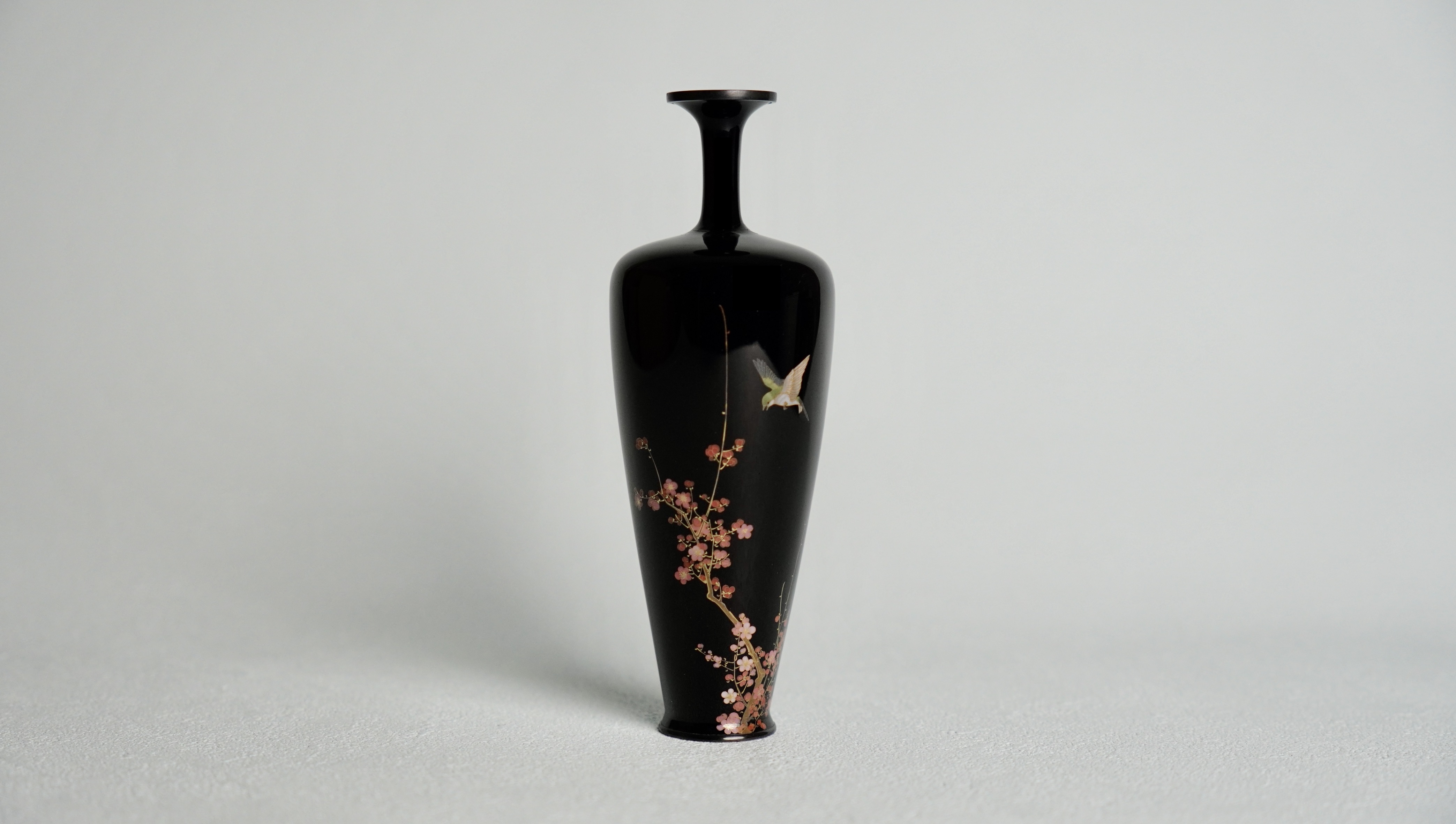
Yasuyuki Namikawa’s works using black transparent glaze (handled by Ginza Shinseido)
Yasuyuki Namikawa has been successful as a cloisonne enamel artist, winning numerous awards at domestic and international expositions. Many cultural figures from abroad visited Namikawa Studio, and the “Kyoto Namikawa” brand was introduced to foreign countries through newspapers and magazines.
In 1896 (Meiji 29), he became a member of the Imperial Household Artists and established himself as a leading cloisonne enamel artist.

(A view of Yasuyuki Namikawa’s studio)
Yasuyuki Namikawa – The four periods and their respective styles
Yasuyuki Namikawa’s works are classified into four periods: the early period (the first period), the second period, the third period, and the later period (the fourth period). The following is an explanation of the characteristics of each.
Early Period (First Period) (1873-1880)

( Yasuyuki Namikawa)

(Vase with chrysanthemum and plum tree design by Yasuyuki Namikawa)
The earliest works in his early period were produced with a glaze (mud cloisonne) without a glossy sheen.
From the middle of the early period, the development of glazes progressed, and works with glossy transparent glazes can be seen. Early works are characterized by the use of “planting lines” throughout the entire surface of the piece and the application of designs and patterns on the entire surface.
Brass wire was mainly used in the early period, but silver and gold-plated wire can be seen in the middle of the early period. Many of these works use ancient designs such as phoenixes and dragons.
Second Period (1880-1890)
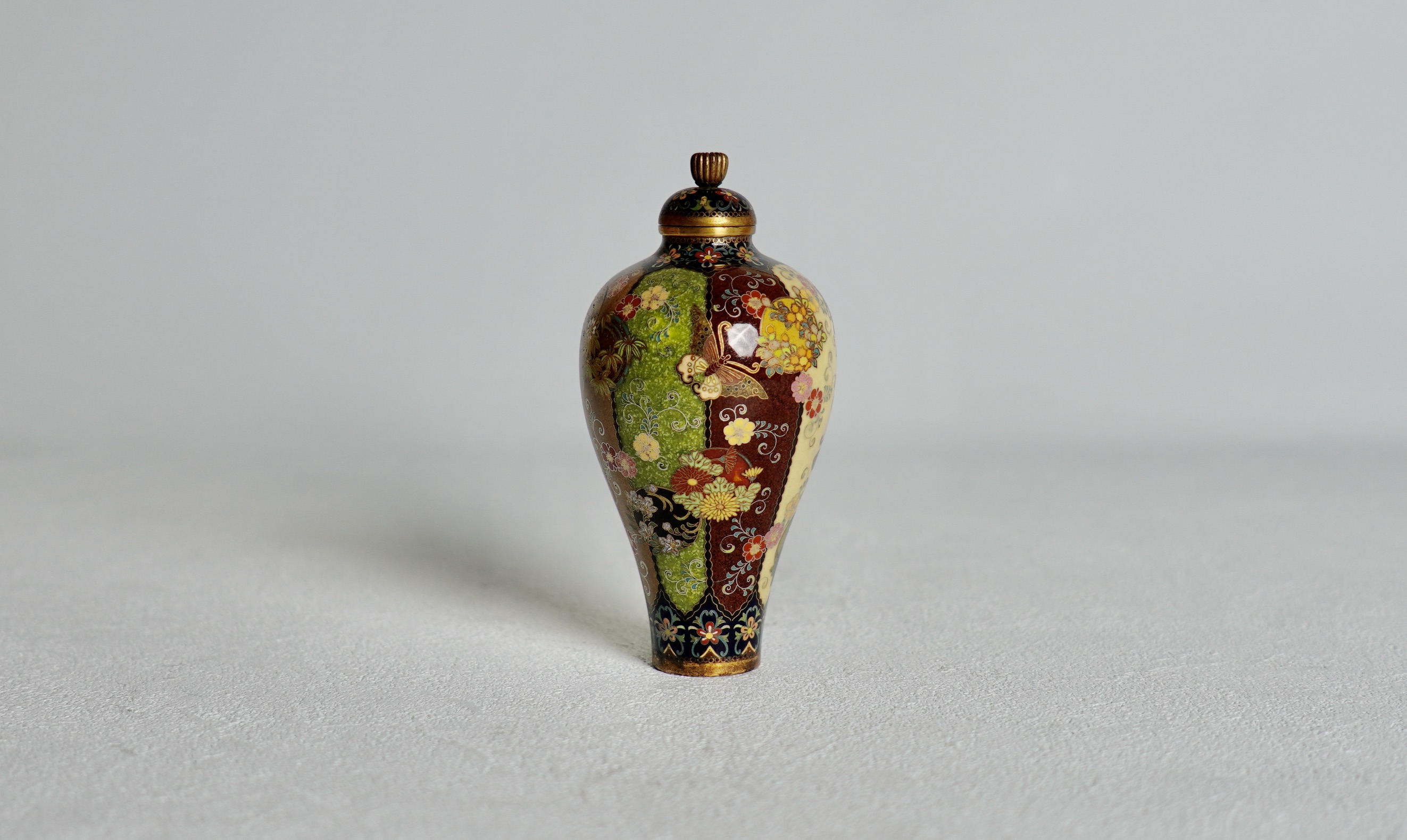
(Jar with cover design of flowers and butterflies by Yasuyuki Namikawa)
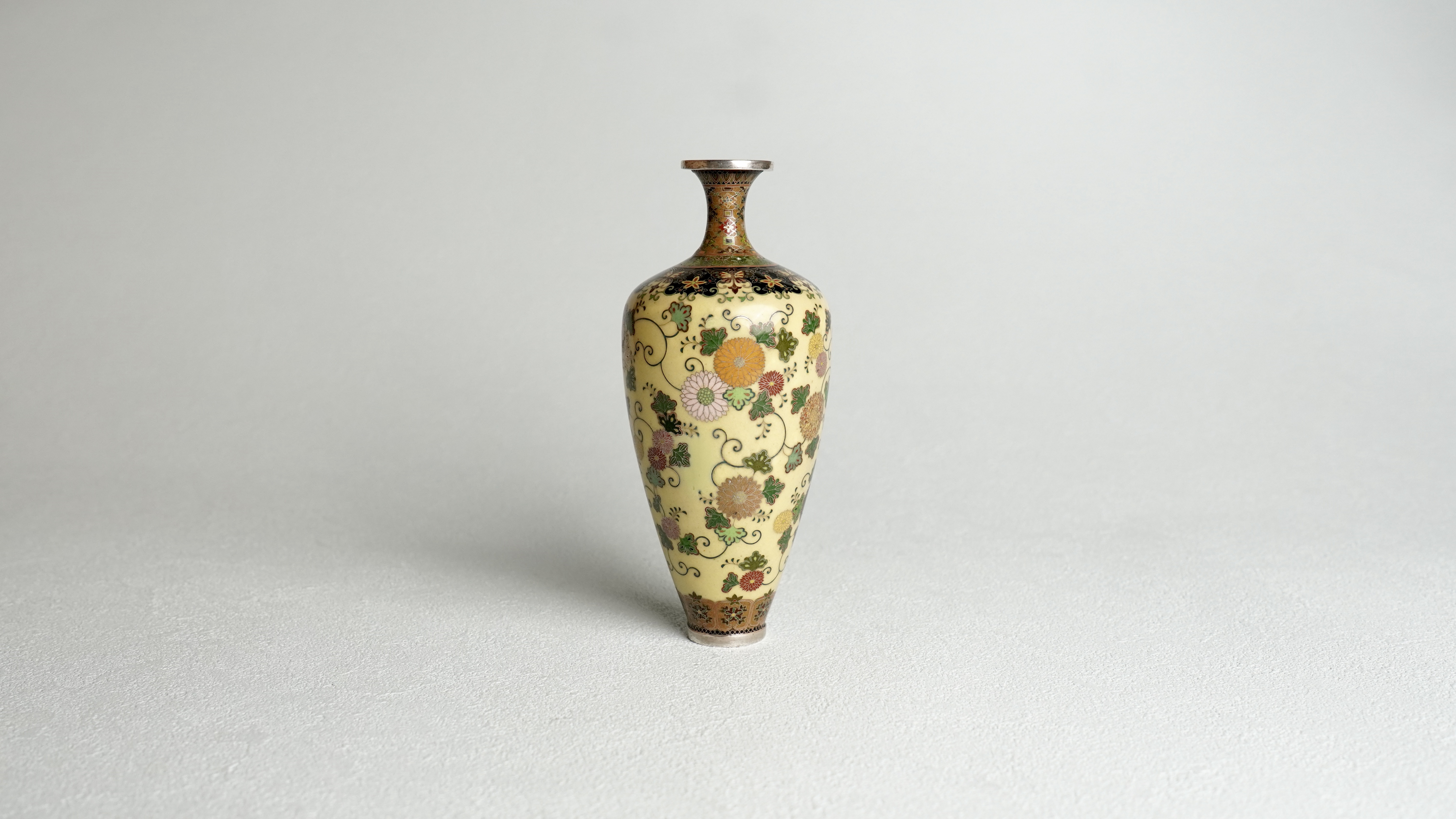
(Vase with chrysanthemum arabesque design by Yasuyuki Namikawa)
The development of glazes continued to progress, and the number of glaze colors available increased dramatically. In this period, brass wire was no longer used, and silver or gold-plated wire was used for the entire planting process. As in the early period, there were many patterns with planted lines throughout, but the production techniques became more advanced and more precise than in the early period.
Third Period (1890-1900)
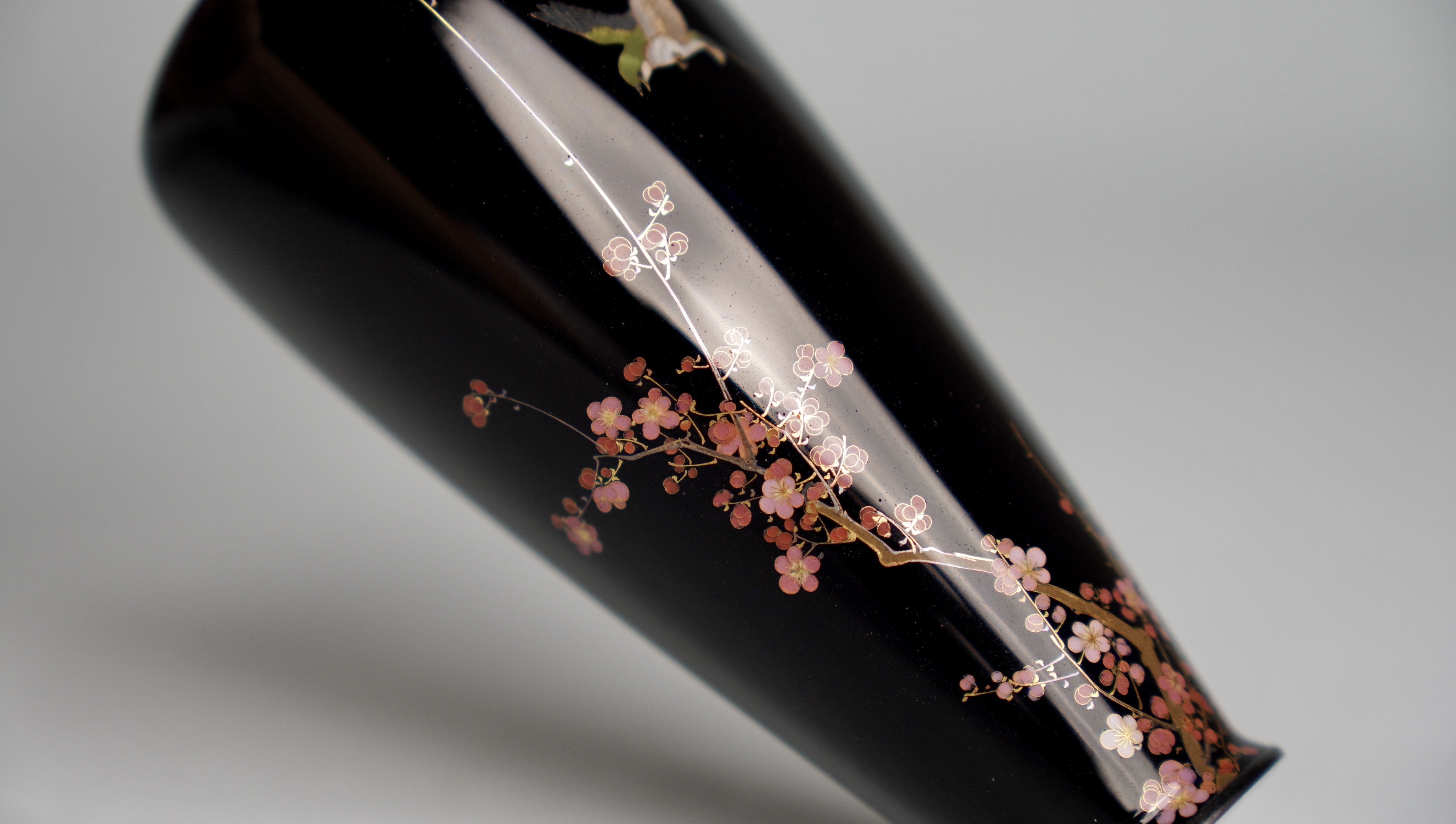
(A work by Yasuyuki Namikawa using gold lines on a background of black transparent glaze )
From this period, silver and gold wire (not gold-plated wire, but gold wire) were used.
The “black transparent glaze” that had been used only for designs and patterns was now also used for backgrounds, and many “Namikawa Black” works can be seen. (Although rare, works using black transparent glaze for the background can also be seen in the early and second periods.)


Vase with wisteria design by Yasuyuki Namikawa (handled by Ginza Shinseido)
In the third period, the pattern-like designs of the past were replaced by realistic designs. This also creates a blank space, and we can see works that express the beauty of elegant blank spaces.
The production technique was further improved, and techniques such as changing the thickness of a single plant line to make it look as if it were painted with a brush were also seen.
Fourth Period (Late) (1900-1923)
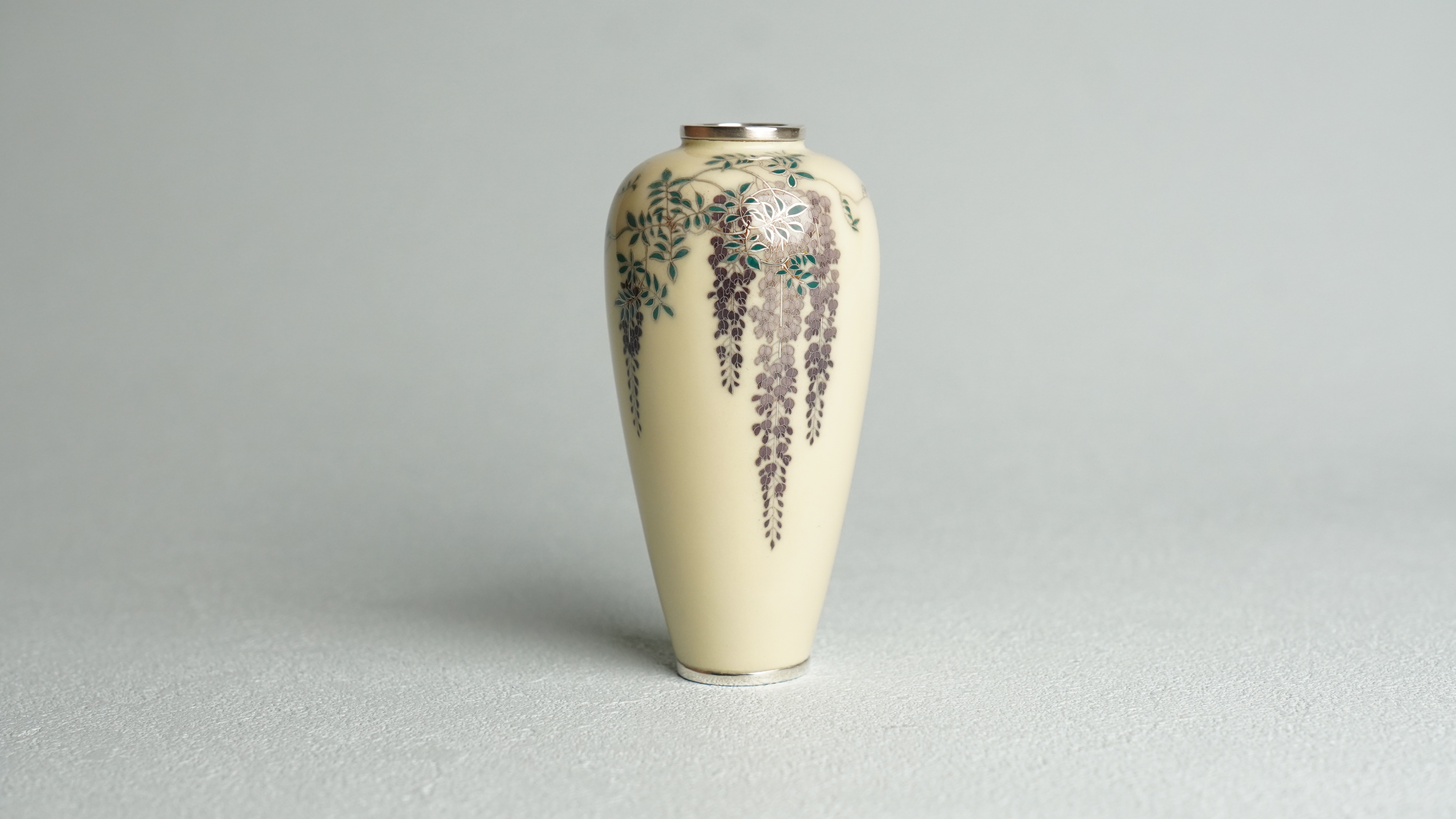
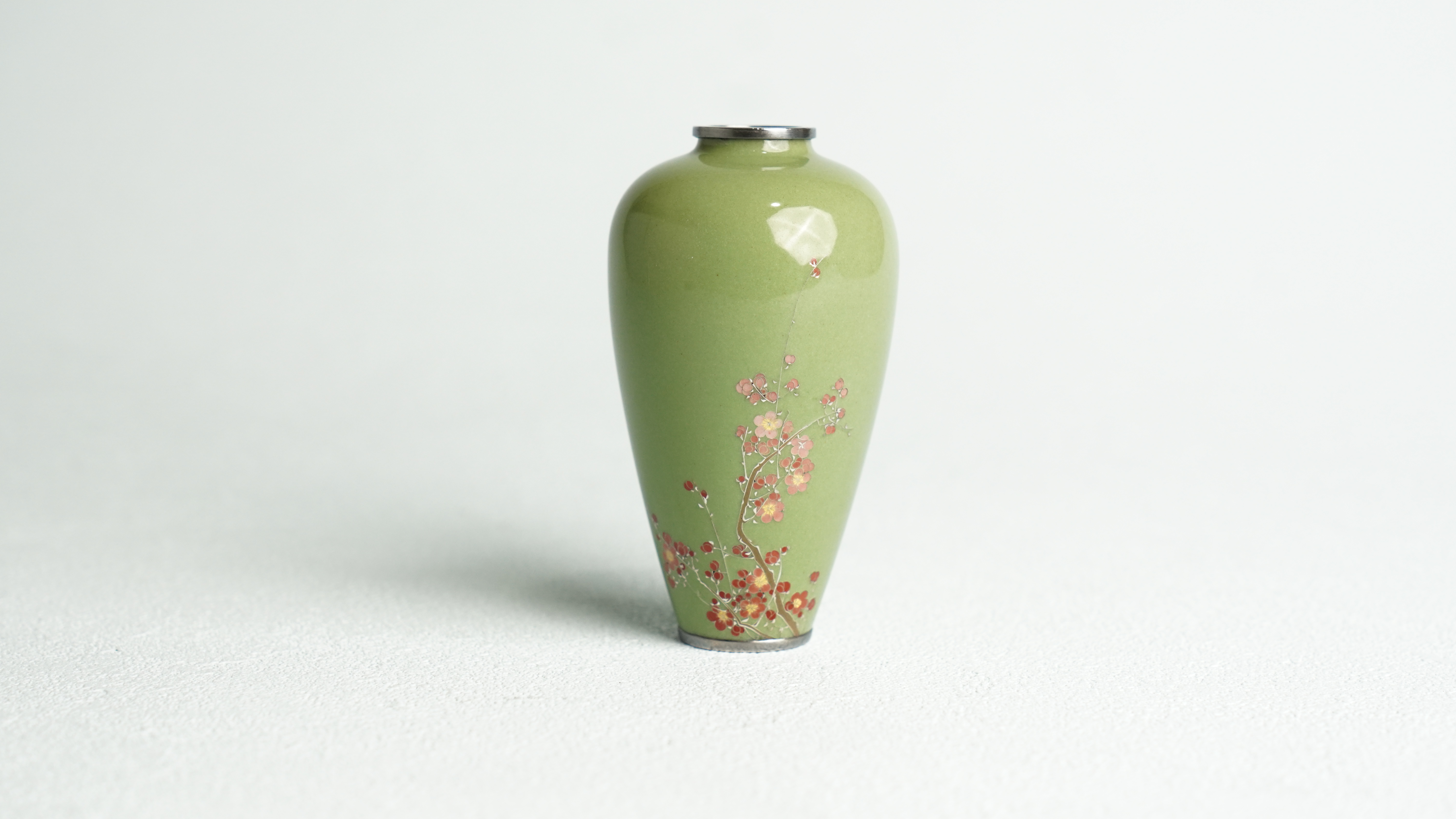
In the later period, there are more blank spaces, but the technique of wired cloisonné enamel painting is high, and as in the third period, it is expressed like an ink painting by brush.
In the late period, more multi-colored glazes could be used, and works with base colors such as cream, white, purple, yellowish green, and pink, which had never been seen before, could be seen.

Cover Jar, Landscape of Kinkakuji Temple, by Yasuyuki Namikawa (handled by Ginza Shinseido)
Characteristics of Yasuyuki Namikawa’s cloisonne enamel ware works
The works of Yasuyuki Namikawa dominated the world with his cloisonne enamel ware technique and gorgeous colors. His works incorporate techniques such as engraving and inlaying, and often depict nature, landscapes, and people’s lives.
There are three characteristics of Yasuyuki Namikawa’s works as follows:
Characteristic 1: Richness of Color

Yasuyuki Namikawa’s work is characterized by the vivid colors he uses. This is a characteristic often seen in cloisonne enamel ware, but it is even more pronounced in his works and has the power to catch the viewer’s eye.
Characteristic 2: Intricate workmanship
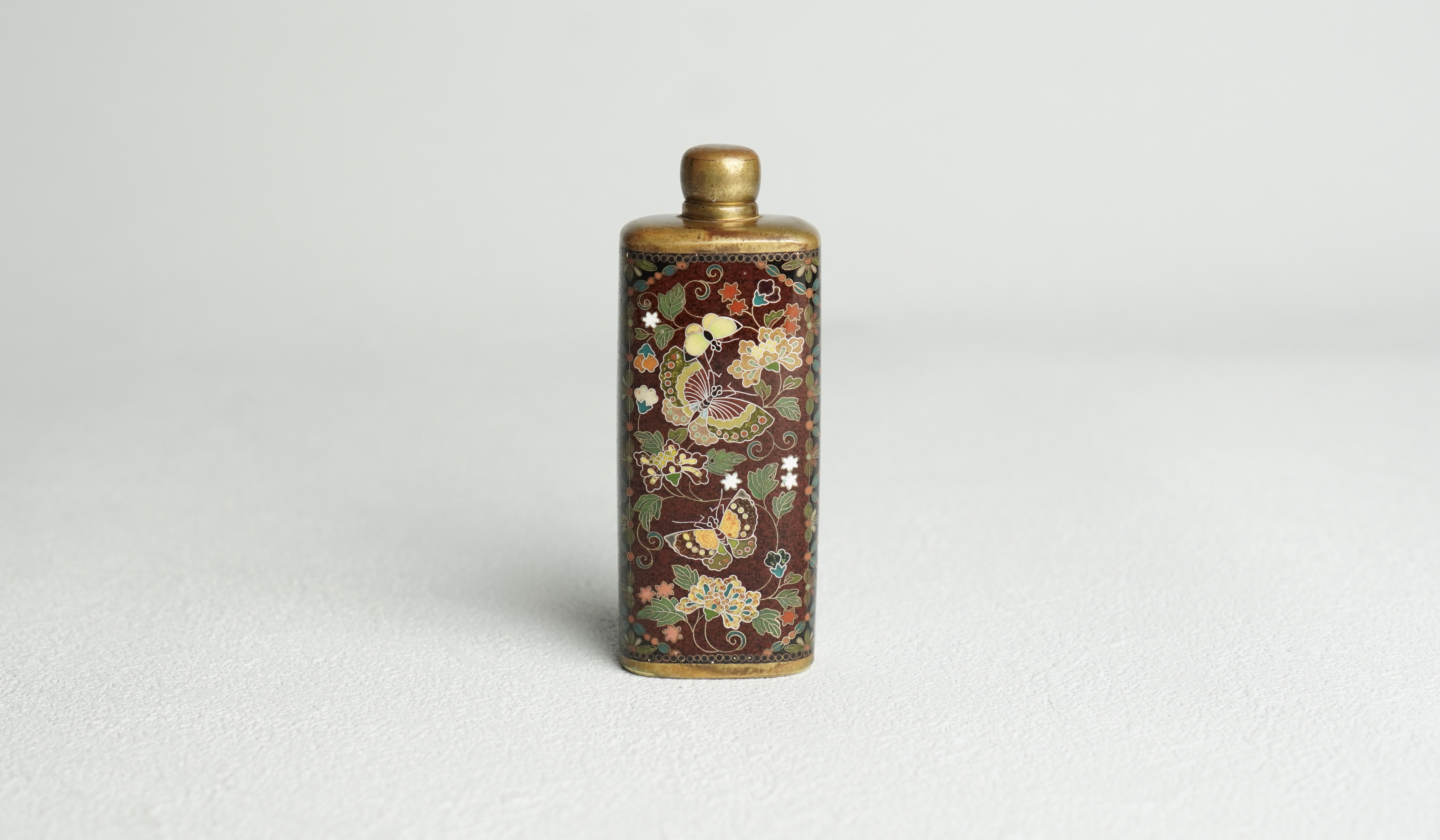
One of the outstanding characteristics of Yasuyuki Namikawa’s work is its meticulous craftsmanship. Each piece is made with painstaking attention to detail, and his technical skill is unrivaled.
Feature 3: Naturalistic Design

Yasuyuki Namikawa’s works often contain elements of nature. Flowers, birds, landscapes, and other elements of nature inspired many of his works, which gives them depth and life.
Prices and Quotations of Yasuyuki Namikawa’s Works
Because of their artistry and rarity, Yasuyuki Namikawa’s works are sold at very high prices. Some of his works are priced in the millions or even tens of millions of yen at auctions.
However, prices vary depending on various factors such as the condition, size, and subject matter of the work. Also, beware of fakes and imitations. In order to obtain authentic Yasuyuki Namikawa works, we recommend that you use a highly reliable art store.
Namikawa Cloisonne Museum of Kyoto

The Namikawa Cloisonne Museum of Kyoto was established to introduce the life and works of the famous cloisonne enamel artist Yasuyuki Namikawa, and is located in his birthplace of Kyoto Prefecture.
The house used as his home and factory is now open to the public as a memorial museum.
At the Namikawa Cloisonne Museum of Kyoto, visitors can not only trace his life, but also see his representative works.
The water was drawn from the Lake Biwa Canal to be used for polishing cloisonne enamel ware. The garden using the Lake Biwa Canal is beautiful and has become a famous sightseeing spot.
The museum also holds regular events, including workshops where visitors can learn and experience the techniques of Yasuyuki Namikawa.
This is a valuable opportunity for those interested in cloisonne enamel ware, especially those who love Yasuyuki’s works.
What is his relationship with Sosuke Namikawa, who was said to be his rival?

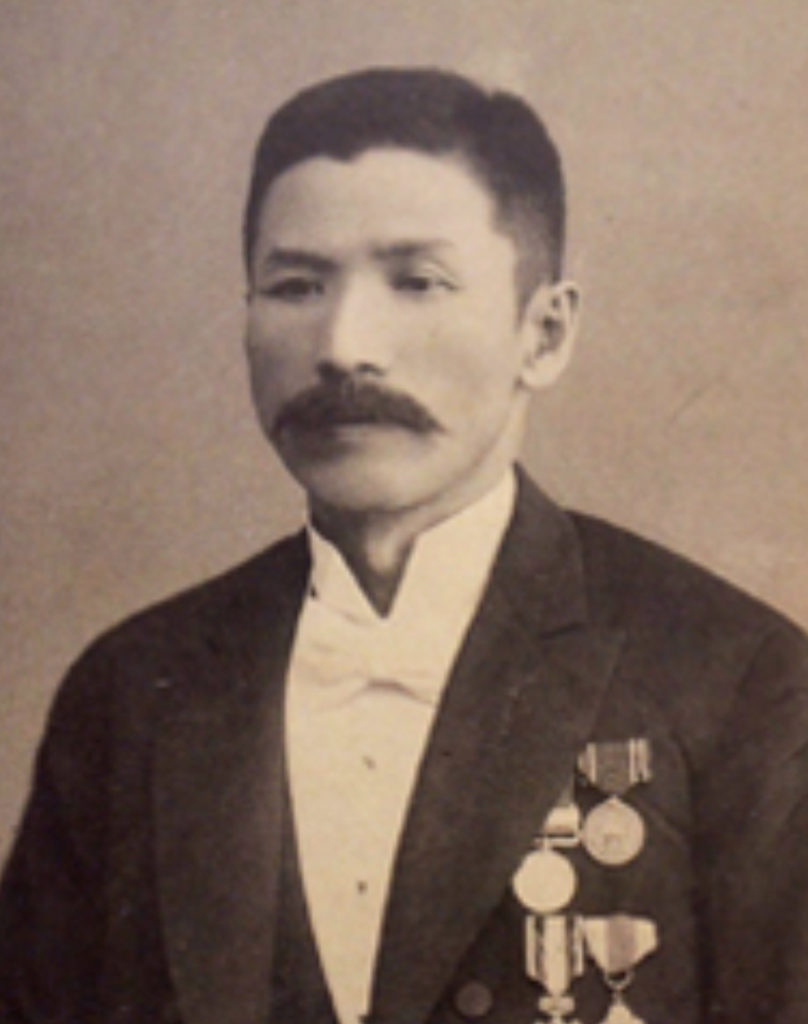
Sosuke Namikawa, a cloisonne enamel ware artisan who was active at the same time as Yasuyuki Namikawa, is often mentioned as a rival of Yasuyuki Namikawa.
Sosuke Namikawa employed an innovative technique called wireless cloisonne enameling to make cloisonne enamel ware.
Wireless cloisonne enamel ware dared to remove the planting lines at the stage before firing the glaze, creating a subtle gradation of colors, which enabled the technique to produce realistic, three-dimensional expressions and soft expressions.
Both Yasuyuki Namikawa and Sosuke Namikawa made their names as masters of cloisonne enamel ware, and their different styles and techniques led the cloisonne enamel ware world in the Meiji era.
Their mutual competition and respect for each other further advanced the art of cloisonne enamel ware to the present day.
Museums where you can see the works of Yasuyuki Namikawa
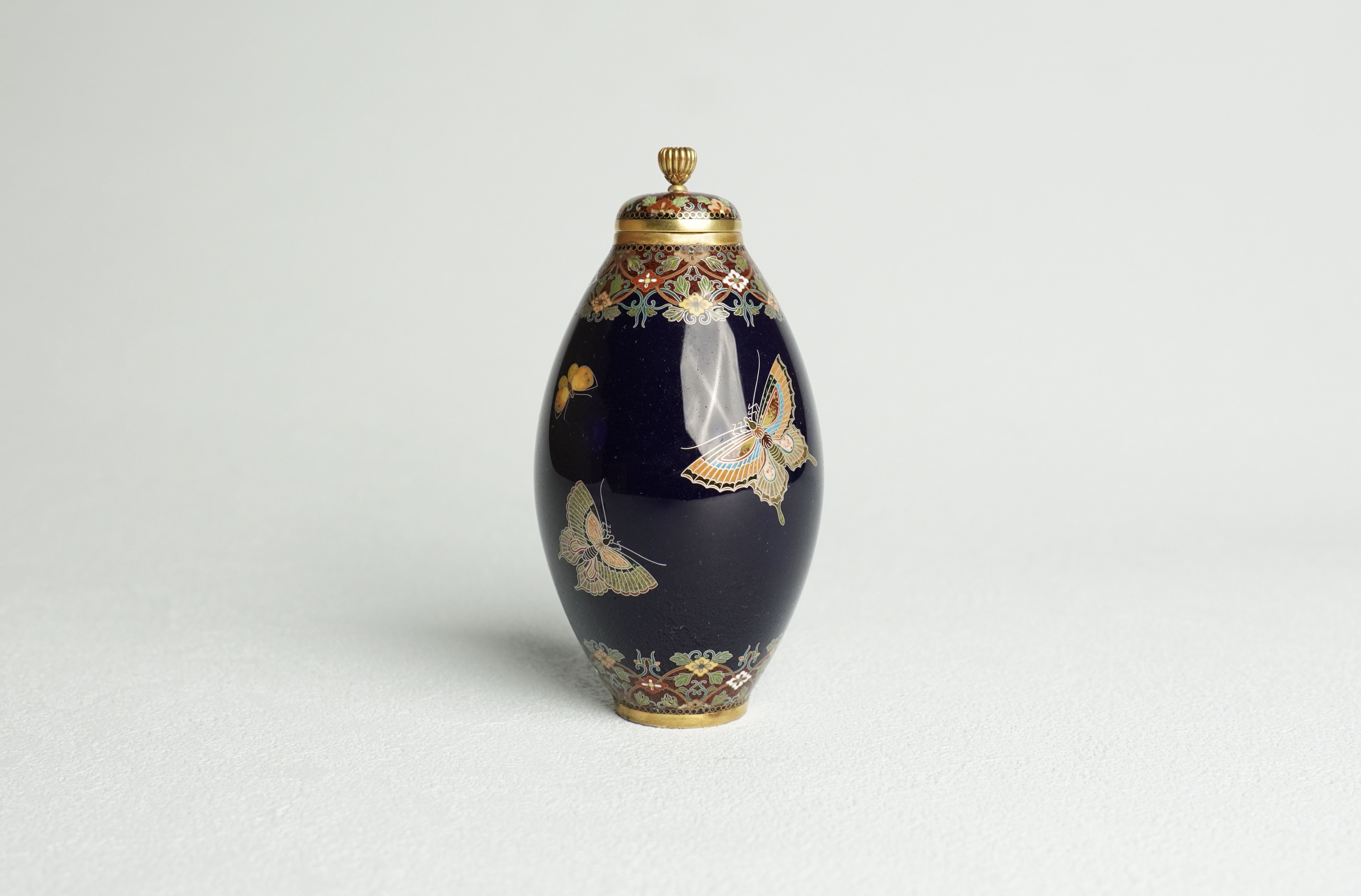
- 並河靖之 七宝記念館 Namikawa Yasuyuki Shippou Museum
- 清水三年坂美術館 Kiyomizu Sannenzaka Museum
- 京都国立近代美術館 The National Museum of Modern Art, Kyoto
- 東京国立博物館 Tokyo National Museum
- V&A美術館(イギリス)V&A Museum (UK)
(Please note that some works may not be exhibited depending on the time of year or the exhibition.)
Yasuyuki Namikawa’s works may be exhibited at various museums and galleries in Japan and abroad.
This is an excellent opportunity to gain a deeper understanding of the world of Yasuyuki Namikawa.
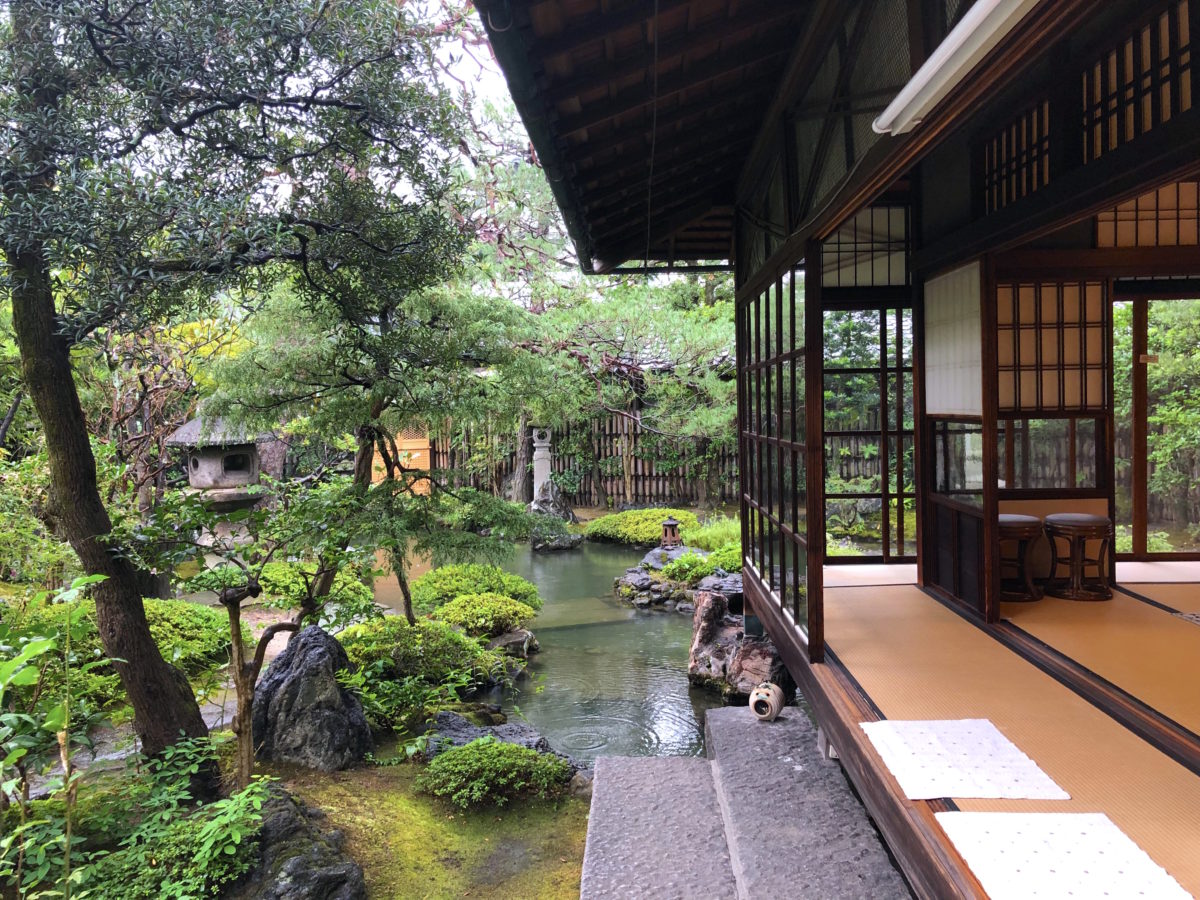
The garden of Yasuyuki Namikawa’s studio
FAQ
What was the international reputation of Yasuyuki Namikawa?
Yasuyuki Namikawa is highly acclaimed both domestically and internationally.
Yasuyuki Namikawa’s works have been awarded many times at international exhibitions such as the Paris World’s Fair and the Chicago World’s Fair. He is deeply loved by Western art lovers and has spread the sophistication and beauty of Japanese craftsmanship throughout the world.
What are some of Yasuyuki Namikawa’s representative works?

One of the most famous of Yasuyuki Namikawa’s works is the “Cloisonne Vase with Four Seasons Flowers and Birds”.
This work was created by order of the Emperor Meiji to be exhibited at the Paris Exposition of 1900. It was awarded a gold medal at the Paris Exposition and is now in the collection of the San-no-Maru Shozokan as one of Yasuyuki Namikawa’s representative works.
The flower-and-bird design is gorgeously painted with gold lines on a black transparent glazed background. The thickness of the gold lines has been changed to make it look as if it were painted with a brush.
This is a gorgeous and skillful work that is worthy of being a masterpiece.
Works by Yasuyuki Namikawa available for sale and viewing at [Ginza Shinseido]
Works by Yasuyuki Namikawa, a master craftsman so well known that they are in the collections of museums in Japan and abroad, are naturally rarely available on the market.
[Ginza Shinseido] has deepened its relationships with museums, overseas collectors, and overseas dealers, and has created its own channels.
Thanks to these efforts, Ginza Shinseido is the only store specializing in cloisonne enamel ware from the Meiji period, and we are always in possession of works by Yasuyuki Namikawa. It is the only gallery in the world where you can actually hold and purchase Yasuyuki Namikawa’s works, which you could only see through glass at art museums.
Ginza Shinseido also engages in cultural activities, such as lending its own works to exhibitions at art museums.
